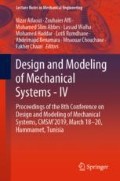Abstract
This paper present a study of the effect of the type of binder on mortars properties reinforced with Doum palm fiber. Two types of binder used for the production of mortars containing Doum palm fiber. Cement is used as a binder for mortar 1 and plaster is used for mortar 2. The mass content of fiber in the test samples was varied from 0.5% to 1.5% with a step of 0.5%. Thermal characteristics of specimens in term of conductivity and diffusivity were studied. Moreover, the flexural and compressive strength of the samples were evaluated. The measurement of the thermal properties of the specimens shows that plaster has the lowest values of thermal conductivity. A report between densities and mechanical properties of these mortars was realized. These results also report that the density of the specimens has an important role in mechanical properties. The more porous is the material present the lower thermal conductivity. For both mortars, the use of Doum palm fiber improves the mortar ductility without affecting the mechanical requirement for construction materials.
Access this chapter
Tax calculation will be finalised at checkout
Purchases are for personal use only
References
Amirul M et al (2017) Australian Journal of Basic And Properties of Mortar with Red Gypsum as Cement Replacement Material by Using Industrial Approach Method, 11 November, pp 115–121. https://doi.org/10.22587/ajbas.2017.11.13.13
Asasutjarit C et al (2007) Development of coconut coir-based lightweight cement board. Constr Build Mater 21(2):277–288. https://doi.org/10.1016/j.conbuildmat.2005.08.028
Buruberri LH, Seabra MP, Labrincha JA (2015) Preparation of clinker from paper pulp industry wastes. J Hazard Mater. Elsevier B.V., 286, pp 252–260. https://doi.org/10.1016/j.jhazmat.2014.12.053
Cement H, Statements B (2002) Standard test method for flexural strength of hydraulic-cement mortars 1(4)
Frías M, Rodríguez O, De Rojas MIS (2015) ‘Paper sludge, an environmentally sound alternative source of MK-based cementitious materials. A Review 74:37–48. https://doi.org/10.1016/j.conbuildmat.2014.10.007
Ismail M (2005) Compressive and tensile strength of natural fibre-reinforced cement based composites, July 2005, pp 1–12
Juenger MCG et al (2011) Cement and concrete research advances in alternative cementitious binders. Cement Concr Res 41(12):1232–1243. https://doi.org/10.1016/j.cemconres.2010.11.012 Elsevier Ltd
Lu J et al (2012) Natural fiber composites for structural. Mater Des 32(1):1–2. https://doi.org/10.1023/A:1021013921916
Mortars C, Statements B (2002) Standard test method for compressive strength of hydraulic-cement mortars (Using Portions of Prisms Broken in Flexure) 1, pp 1–4
Raut SP et al (2012) Reuse of recycle paper mill waste in energy absorbing light weight bricks. Constr Build Mater 27(1):247–251. https://doi.org/10.1016/j.conbuildmat.2011.07.053 Elsevier Ltd
Raut S, Ralegaonkar R, Mandavgane S (2013) ‘Utilization of recycle paper mill residue and rice husk ash in production of light weight bricks. Arch Civil Mech Eng 13(2):269–275. https://doi.org/10.1016/j.acme.2012.12.006 Elsevier
Sedan D et al (2008) Mechanical properties of hemp fibre reinforced cement: influence of the fibre/matrix interaction 28:183–192. https://doi.org/10.1016/j.jeurceramsoc.2007.05.019
Silva LM et al (2010) Cement & concrete composites role of lightweight fillers on the properties of a mixed-binder mortar. Cement Concr Compos 32(1):19–24. https://doi.org/10.1016/j.cemconcomp.2009.07.003 Elsevier Ltd.
Tolêdo Filho RD et al (2000) Durability of alkali-sensitive sisal and coconut fibres in cement mortar composites. Cement Concr Compos 22(2):127–143. https://doi.org/10.1016/S0958-9465(99)00039-6
Zhou X et al (2013) Materia ls and design fracture and impact properties of short discrete jute fibre-reinforced cementitious composites. J Mater Design 49:35–47. https://doi.org/10.1016/j.matdes.2013.01.029 Elsevier Ltd.
Author information
Authors and Affiliations
Corresponding author
Editor information
Editors and Affiliations
Rights and permissions
Copyright information
© 2020 Springer Nature Switzerland AG
About this paper
Cite this paper
Fatma, N., Lamis, A., Redouane, Z., Mondher, Z. (2020). Effect of the Type of Binder on Thermal and Mechanical Properties of Mortar with Doum Palm Fiber. In: Aifaoui, N., et al. Design and Modeling of Mechanical Systems - IV. CMSM 2019. Lecture Notes in Mechanical Engineering. Springer, Cham. https://doi.org/10.1007/978-3-030-27146-6_49
Download citation
DOI: https://doi.org/10.1007/978-3-030-27146-6_49
Published:
Publisher Name: Springer, Cham
Print ISBN: 978-3-030-27145-9
Online ISBN: 978-3-030-27146-6
eBook Packages: EngineeringEngineering (R0)

